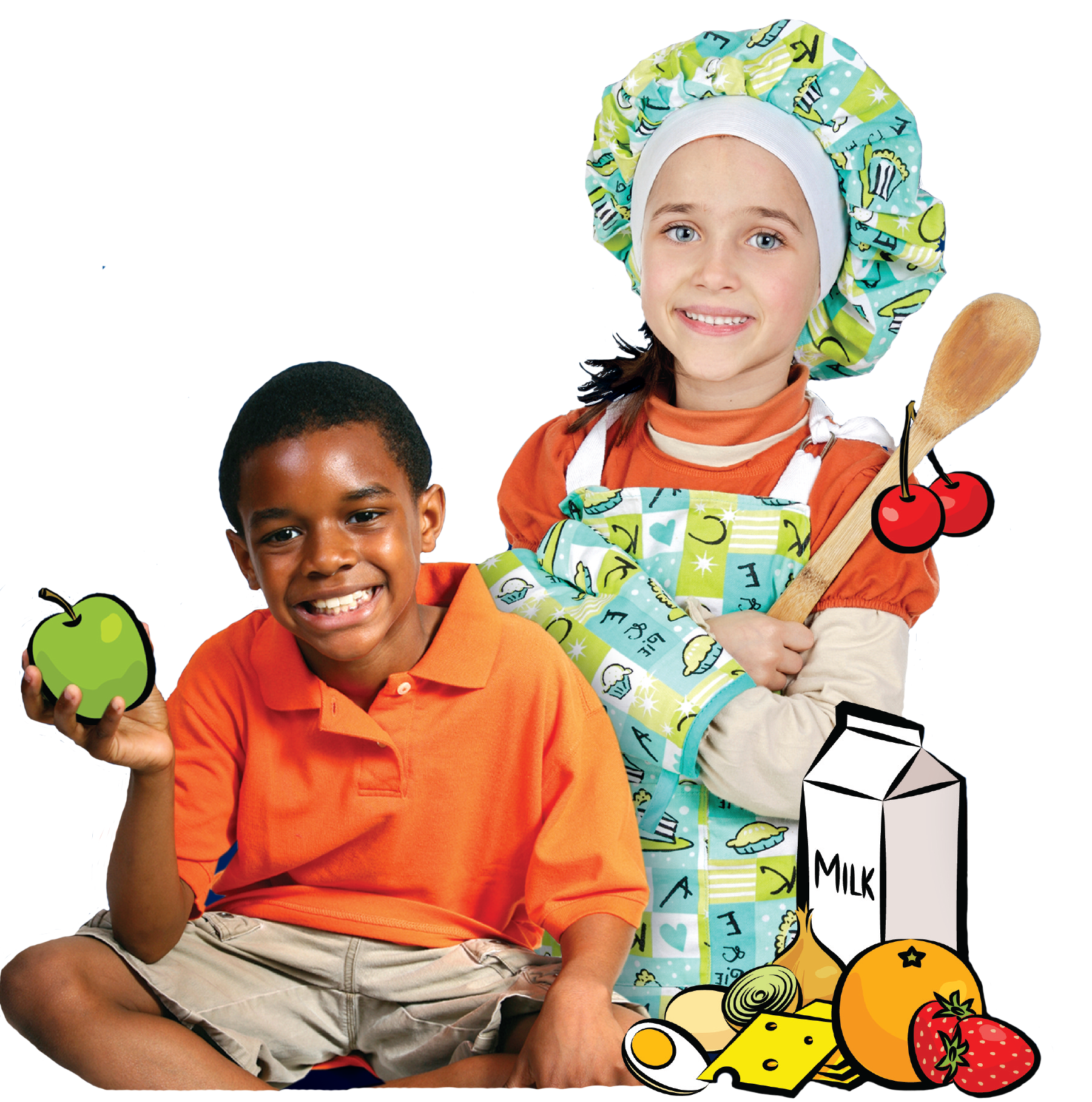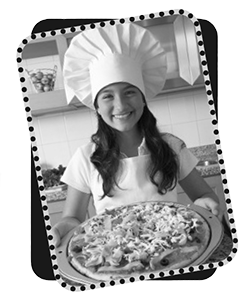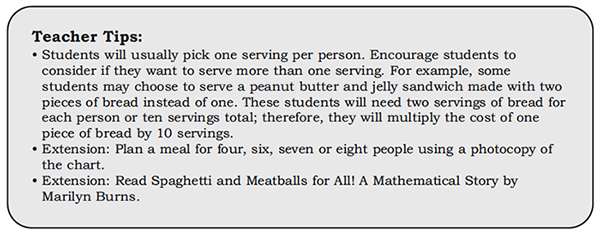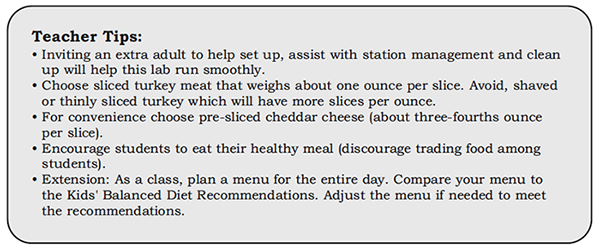Agricultural Literacy Curriculum Matrix
Lesson Plan
FoodMASTER: Meal Management
Grade Level
Purpose
Students choose foods from each of the five food groups to create a meal and calculate the cost of serving the meal to five people and to one person. Students are challenged to plan, prepare, evaluate, and eat a lunch meal that costs less than $1.50 per person. Grades 3-5
Estimated Time
Materials Needed
Activity 1: Menu Madness
- For the teacher: 1 deck of cards (representing 2-3 ounces of meat), 1 tennis ball, 1 tablespoon, 1 set of measuring cups, 1 half-pint milk carton; Teacher Answer Key
- For each student: pencil, Menu Madness Handout
Activity 2: Nutritious and Delicious
- For the teacher: 1 set dry measuring cups, 1 set measuring spoons, 1 paper plate, 1 kitchen scale, 1 liquid measuring cup
- For each student: 1 plate, 8-ounce cup, 1 slice 100% whole wheat bread, 1 slice turkey lunchmeat (1 ounce), 1 slice cheddar cheese (3/4 ounce square slice), 1/2 cups baby carrots, 1 ounce mini pretzels, 1 cup water; Nutritious and Delicious Handout Optional: Light mayonnaise (1 tablespoon or less per child), mustard, leaf lettuce, table knife to spread mayonnaise and mustard.
Elaborate
Vocabulary
menu: a list of the dishes or food available at a restaurant
recipe: instructions and a list of ingredients for making a food dish
Background Agricultural Connections
Introduction to FoodMASTER:
FoodMASTER (Food, Mathematics and Science Teaching Enhancement Resource) is a compilation of programs aimed at using food as a tool to teach mathematics and science. It is our theory that if food is used as a tool to teach mathematics and science, students will be better prepared to demonstrate and apply mathematic and scientific knowledge. Because students encounter food on a daily basis, they have preexisting contextual experiences preparing them for learning new and relevant mathematics and science material.
Food is conducive to hands-on and virtual, inquiry-based, active learning that uses multiple senses to engage students in the learning process. Utilizing food allows for an interdisciplinary approach to learning concepts and ideas in a variety of scientific subjects like general science, biology, chemistry, microbiology, nutrition and health. Additionally, food labs are a dynamic way to teach mathematics concepts such as numbers and operations, algebra, geometry, measurement and problem solving.
The knowledge and skill development that can be inspired by the FoodMASTER approach is limitless. Proper use of measurement tools, data collection and interpretation, application and generalization, classification and organization, graphing and comparative analysis, understanding chemical changes, observing functions of ingredients and controlling variables, pricing, critical thinking, self-directing learning, and team building are only a few of the potential knowledge and skill development areas for intermediate grade students experiencing FoodMASTER’s scientific inquiry labs.
Additional FoodMASTER lessons can be found to cover health and nutrition topics such as:
- Food Safety
- Vegetables
- Fruits
- Meat, Poultry, and Fish
- Eggs
- Fats and Oils
- Grains
- Measurement
- Meal Management
Background for this Lesson:
Meal planning is an important part of creating a healthy meal. You may do a lot of planning for special meals like birthdays and holiday dinners. But it is easy to forget to plan everyday meals. Try planning week day meals to help your family make healthy choices, spend less money and save time at the grocery store. In this lesson, your students will learn how to plan a healthy meal.
In this lesson, students will:
- name the five food groups;
- be introduced to serving sizes;
- record data in a table and practice addition, multiplication and division to solve multi-step money mathematics problems;
- plan a meal on a limited budget;
- correctly measure food and recognize one serving of grains (one ounce), one serving of vegetables (one-half cup) and one serving of dairy (one cup); and
- solve kitchen mathematics problems using subtraction.
Engage
- Discuss with your students what the word "balanced" means. Balance means that different elements are equal or in correct proportion with one another.
- Relate the word, "balanced" with our diets. What does it mean to have a balanced diet? Teach students that the foods they eat should be in correct proportions. Meat is a good and healthy part of our diet, but not if we eat too much. Fruits and vegetables are a part of a balanced diet, but many people do not eat enough fruits and vegetables.
- Consider drawing a balance scale or a teeter totter on the board to help students visualize balance as you introduce the lesson.
- As students begin to visualize a "balanced" meal, remind them that each food item was originally produced on a farm. Some farmers produce plants or crops to provide grains, fruits, and vegetables to our diets. Other farms raise animals who produce eggs, dairy products, and various meats.
- Teach students that it takes a variety of farms and farmers to provide a healthy, balanced diet. Today they will be learning how to plan and prepare a balanced meal. If time allows, read one of the books recommended in the "Suggested Companion Resources" section of the lesson.
Explore and Explain
Activity 1: Menu Madness
Scientific Inquiry: Money Matters

- Read Menu Madness and complete the Doodle Bugs.
- Explain to students that they will have a chance to plan a meal today.
- Review the five food groups (grains, vegetables, fruits, dairy and protein foods). Help students get a feel for serving sizes. Explain that two to three ounces of meat is about the size of a deck of cards, one ounce or one cup of cereal is about the size of a tennis ball, one cup of milk is the amount served with school lunch. Show students a deck of cards, a tennis ball, a half-pint milk carton, a one-cup measure, a one-half-cup measure and one tablespoon.
- Students will then follow the instructions to plan a menu. First, they will circle one food from each food group. Then they will record the food, price and number of servings needed to feed five people.
- Next, students will calculate the cost of each food when feeding five people. Finally, students will use addition to calculate the total cost of feeding five people.
- Students will complete the two questions and then move on to the challenge if time allows.

Activity 2: Nutritious and Delicious
Scientific Inquiry: Let's do Lunch
- Read Nutritious and Delicious and complete the Doodle Bugs.
- Read Kids' Balanced Diet Recommendations as a class paying special attention to foods that belong in each food group and serving sizes. Visuals may help such as pictures and measuring cups.
- Set up a sandwich station (bread, turkey, cheese, mayonnaise, mustard, leaf lettuce and table knife), carrot station (carrots and measuring cups), pretzel station (pretzels, paper plate and scale) and water station (water and liquid measuring cup).
- Students will complete Scientific Inquiry: Let’s do Lunch by rotating through each station, measuring the correct amount of each food to create lunch.
- When your students have visited each station, instruct them to complete the table by using the Kids' Balanced Diet Recommendations to help them decide on amounts. You may complete “whole wheat bread” as an example for the class (one slice of bread = one ounce from the grains group).
- Students will then use the chart to evaluate their lunch and answer the remaining questions.
Students may enjoy eating the lunch they prepared! 
Elaborate
-
Bistro Menu: A "Bistro" is a small restaurant. Assign your students to apply what they have learned and design a menu for an imaginary bistro. They can create "specials" that provide nutritionally balanced meals for guests.
-
Read Issue 2 of Ag Today titled Food, Keeping us Fueled for an Active Lifestyle. This reader can be accessed digitally. Learn about the healthy and tasty food that farmers grow to help humans maintain a healthy diet. Follow the process from farm to plate and learn about serving sizes, food safety, and USDA's MyPlate.
-
Food on the Road: Complete the math enrichment activity. Students will learn about the transportation of food from the farmer to the consumer and calculate shipping distances and costs.
Evaluate
After conducting these activities, review and summarize the following key concepts:
- A healthy diet includes a variety and correct balance of fruits, vegetables, grains, meat, and dairy products.
- The food we eat is produced on farms, processed and packaged, then sold to consumers in grocery stores.
Acknowledgements
- Created by: FoodMASTER- Food, Math, and Science Teaching Enhancement Resource
- Sponsored by: SEPA- Science Education Partnership Award
- Partnered with: Ohio University and East Carolina University
- Graphics provided by FoodMASTER
Recommended Companion Resources
- Ag Today
- Eat Happy Project Video Series
- Food Doesn't Grow in the Supermarket!
- Food Group Puzzle
- Higher or Lower: Ingredient Investigation
- How Did That Get in My Lunchbox?
- Look Inside Food
- Mapping Meals Activity
- Nutrition Posters
- Portion Size Comparison
- The Science of Cooking
- What's For Lunch?
- Who Grew My Soup?
Author
Organization
| We welcome your feedback! If you have a question about this lesson or would like to report a broken link, please send us an email. If you have used this lesson and are willing to share your experience, we will provide you with a coupon code for 10% off your next purchase at AgClassroomStore. |
